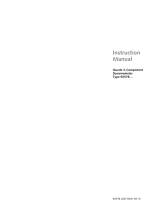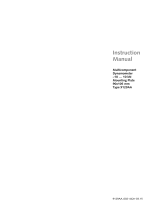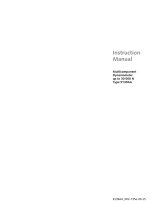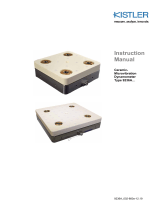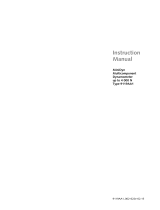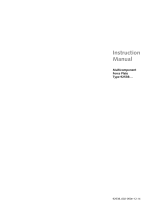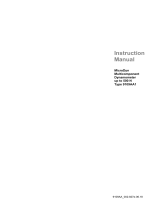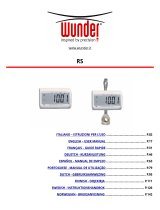Page is loading ...

Instruction
Manual
Quartz
4
-Component
Dynamometer
Type 9272
9272_002-057e-09.08

Instruction
Manual
Quartz 4-
Component Dyna-
mometer
Type 9272
9272_002-057e-09.08
Quartz
4-Component
Dynamometer
Type 9272


Foreword
9272_002-057e-09.08 Page 1
Foreword
We thank you for choosing a Kistler quality product distin-
guished by technical innovation, precision and long life.
Information in this document is subject to change without
notice. Kistler reserves the right to change or improve its
products and make changes in the content without obliga-
tion to notify any person or organization of such changes
or improvements.
© 2008 Kistler Group. All rights reserved. Except as ex-
pressly provided herein, no part of this manual may be re-
produced for any purpose without the express prior written
consent of Kistler Group.
Kistler Group
Eulachstrasse 22
8408 Winterthur
Switzerland
Tel. +41 52 224 11 11
Fax +41 52 224 14 14
www.kistler.com

Quartz 4-Component Dynamometer Type 9272
Page 2 9272_002-057e-09.08
Content
1. Introduction ................................................................................................................................... 4
2. Important Information.................................................................................................................... 5
2.1 For your Safety..................................................................................................................... 5
2.2 How to Treat the Instrument................................................................................................ 6
2.3 Tips for Using the Operating Instructions ............................................................................. 6
2.4 What Happens after Modifications?..................................................................................... 7
3. General description of the instrument............................................................................................ 8
3.1 What Does a Multicomponent Dynamometer Do? .............................................................. 8
3.2 Functional Principle .............................................................................................................. 9
3.3 Design of the Dynamometer .............................................................................................. 10
4. Assembly, Installation and Putting into Operation...................................................................... 11
4.1 Important Remarks............................................................................................................. 11
4.2 Assembling the Dynamometer ........................................................................................... 11
4.3 Basic Circuitry and Cabling of the Measuring System ......................................................... 12
4.4 Cutting Force Measurement in Drilling............................................................................... 13
4.4.1 Force and Moment Measuring with 4 Components (Fx, Fy, Fz, Mz)................................... 15
4.4.2 Signal Conditioning ............................................................................................................ 15
4.4.3 Data Acquisition and Evaluation......................................................................................... 15
4.5 Force Application ...............................................................................................................16
4.5.1 Correlations for Simultaneous Loading in two or more Components.................................. 16
4.5.2 Correlation Fx, y – Mz........................................................................................................ 17
4.5.3 Correlation Mz – Mx, y....................................................................................................... 17
4.5.4 Correlation Fx, y – Fz.......................................................................................................... 18
5. Operation..................................................................................................................................... 19
5.1 Range Selection.................................................................................................................. 19
5.2 Measuring Small Force Changes......................................................................................... 19
5.3 Usable Frequency Range.................................................................................................... 21
5.4 Temperature Influences...................................................................................................... 22
5.5 Polarity of the Measuring Signal......................................................................................... 22
6. Maintenance ................................................................................................................................ 23
6.1 Recalibrating the Instrument .............................................................................................. 23
6.2 Maintenance Tasks............................................................................................................. 23
7. Trouble shooting.......................................................................................................................... 24
7.1 Tracing Faults and Remedying Them.................................................................................. 24
7.2 Defective Dynamometer .................................................................................................... 25
8. Technical Data ............................................................................................................................. 26
8.1 4-Component Dynamometer Type 9272 ........................................................................... 26
8.2 Technical Data for Turning; Force Acting onto Point A....................................................... 28
8.3 Included Accessories........................................................................................................... 29
8.4 Optional Accessories .......................................................................................................... 29

Content
9272_002-057e-09.08 Page 3
9. Annex ...........................................................................................................................................30
9.1 Glossary ..............................................................................................................................30
9.2 Measurement Uncertainty ..................................................................................................33
9.3 Linearity..............................................................................................................................34
9.4 Frequency Range ................................................................................................................36
9.5 Influence of Temperature....................................................................................................37
9.6 Index ..................................................................................................................................39
Total pages 39

9272_002-057e-09.08 Page 4
1. Introduction
Please take the time to thoroughly read this instruction
manual. It will help you with the installation, maintenance,
and use of this product.
Kistler offers a wide range of products for use in measuring
technology:
Piezoelectric sensors for measuring force, torque, strain,
pressure, acceleration, shock, vibration and acoustic-
emission
Strain gage sensor systems for measuring force and
moment
Piezoresistive pressure sensors and transmitters
Signal conditioners, indicators and calibrators
Electronic control and monitoring systems as well as
software for specific measurement applications
Data transmission modules (telemetry)
Kistler also develops and produces measuring solutions for
the application fields engines, vehicles, manufacturing,
plastics and biomechanics sectors.
Our product and application brochures will provide you
with an overview of our product range. Detailed data
sheets are available for almost all products.
If you need additional help beyond what can be found ei-
ther online or in this manual, please contact Kistler's exten-
sive support organization.

Important Information
9272_002-057e-09.08 Page 5
2. Important Information
Please keep to the following rules without fail. This will en-
sure your personal safety when working, and assure long,
trouble-free performance by the instrument.
2.1 For your Safety
This instrument has been tested thoroughly and it left
the works in a perfectly safe condition. To maintain this
condition and assure safe operation, the user must ob-
serve the directives and warnings contained in these in-
structions
The dynamometer must be installed, operated and
maintained only by persons who are familiar with it and
adequately qualified for their particular tasks
When it must be assumed that safe operation is no
longer possible, the instrument must be taken out of
operation and secured against unintentional use
It must be assumed that safe operation is no longer possi-
ble if:
The instrument is visibly damaged,
It no longer functions,
It has been in lengthy storage under adverse conditions,
It has received rough treatment during transport
For measuring cutting forces, fix the dynamometer on the
machine tool according to the instructions. See section
4.2: Assembling the Dynamometer, for details.
Fix all parts mounted on the top plate of the dynamome-
ter according to the forces expected!

Quartz 4-Component Dynamometer Type 9272
Page 6 9272_002-057e-09.08
2.2 How to Treat the Instrument
The dynamometer may be used only under the speci-
fied environmental and operating conditions
The insulation resistance is crucially important with pie-
zoelectric measurements. It must be around 1014 Ω (but
at least 1013 Ω)
To obtain this resistance, all plug and socket connec-
tions must be kept meticulously clean and dry
The insulation resistance can be measured with the in-
sulation tester Type 5493
Protect the signal output against dirt and do not touch
it with your fingers. When the connection is not being
used, cover it with the cap provided
The connecting cable from dynamometer to charge
amplifier is highly insulating. Use only the proper cable
Do not remove the connecting cable from the dynamo-
meter
When the dynamometer is not in use, protect it by
keeping it in the packing case supplied
When performing long-time measurements, make sure
that the temperature of the dynamometer remains as
constant as possible
2.3 Tips for Using the Operating Instructions
We recommend reading the entire Operating Instructions
as a matter of principle. If you're in a hurry, however, and
you've already gathered experience with Kistler dynamo-
meters, you can confine your reading to the information
that you really need.
We have endeavoured to arrange these instructions so that
you can find the information you need without difficulty.
Please keep these Operating Instructions in a safe place
where they can be consulted any time.
If the instructions get lost, just turn to your Kistler customer
service station and they will be replaced without delay.
All information and directives in these instructions may be
modified at any time without prior notification.

Important Information
9272_002-057e-09.08 Page 7
2.4 What Happens after Modifications?
Modifications to instruments result in alterations of the op-
erating instructions as a rule. In such cases, enquire at your
Kistler customer service station about the possibilities of
updating your documentation.
Please note that all technical data and all other information
in this section may be altered at any time without prior no-
tice.

Quartz 4-Component Dynamometer Type 9272
Page 8 9272_002-057e-09.08
3. General description of the instrument
3.1 What Does a Multicomponent Dynamometer Do?
The multicomponent dynamometer provides dynamic and
quasistatic measurement of the 3 orthogonal components
of a force (Fx, Fy, Fz) acting from any direction onto the top
plate as well as the moments Mz.
The dynamometer has high rigidity and hence high natural
frequency. The high resolution enables very small dynamic
changes to be measured in large forces.
The dynamometer measures the active cutting force re-
gardless of its application point. Both the average value of
the force and the dynamic force increase may be meas-
ured. The usable frequency range depends mainly on the
resonance frequency of the entire measuring rig.
Fig. 1: 4-Component Dynamometer Type 9272

General description of the instrument
9272_002-057e-09.08 Page 9
Most important applications for the multicomponent dy-
namometer are:
Measuring feed force, side force and moment in
drilling, tapping etc.
Measuring cutting forces in milling and grinding and
turning high sensitivity and calibrated part ranges allow
exact measurements even on small tools and when
grinding;
Measurements on wind tunnel models
Ergonomic measurements
Testing of torque wrenches
Testing of springs (torison)
Measurements on small thrust bearings, slip clutches
etc.
Measurements of starting torques of small motors and
step motors
Measurements in ergonomics
3.2 Functional Principle
The force and the moment Mz acting on the dynamometer
are transmitted through the top plate to a 4-component
load washer.
This 4-component sensor contains 3 pairs of quartz rings,
where by one is sensitive to compression and the other two
are sensitive to shear either in x- resp. in y-direction. An
additional set of shear sensitive quartz plates is arranged on
such a way to yield an electrical charge proportioned to the
Moment Mz acting about the axis of the sensor. The acting
force is directly resolved into its three components. The
charges yielded by the quartz plates are collected with
electrodes connected to the connector of the sensor.
Fig. 2: Construction of a 4-Component Sensor
Depending on the direction of the force and moments,
positive or negative charges occur at the connections.
Negative charges give positive voltages at the output of
the charge amplifier, and vice versa.

Quartz 4-Component Dynamometer Type 9272
Page 10 9272_002-057e-09.08
3.3 Design of the Dynamometer
The dynamometer consists of a 4-component load washer
sandwiched under high preload between a baseplate and a
top plate.
This preload is needed to transmit the friction forces.
Fig. 3: Construction of the dynamometer Type 9272
1 4-Component Sensor
2 Baseplate
3 Top plate
4 Connecting plug
5 Preloaded screw
The sensor is mounted ground-insulated. Ground loop
problems are largely eliminated in consequence.
The dynamometer is rustproof and protected against in-
gress of splashwater and coolant. Together with the con-
necting cable Type 1677A5/1679A5 the dynamometer
meets the requirements of protection class IP67.

Assembly, Installation and Putting into Operation
9272_002-057e-09.08 Page 11
4. Assembly, Installation and Putting into Operation
4.1 Important Remarks
The multicomponent dynamometer Type 9272 is a preci-
sion instrument, but its inherent accuracy can be exploited
and retained only if it is treated with care. The following
rules should therefore be noted:
Never drop the dynamometer or expose it to heavy im-
pacts! The maximum force of a shock of this kind could
exceed the measuring range of the instrument and
cause permanent deformations
Never use a hammer to position the workpieces, as
such blows might also cause deformation
On the following pages you will find directions for install-
ing the dynamometer and basic data for designing the
measuring facility.
4.2 Assembling the Dynamometer
The following directions must be observed if the dynamo-
meter is to be mounted properly:
The dynamometer must be installed only by persons
who are familiar with it and sufficiently qualified for this
work
First the connecting cable has to be mounted. Both
connector sides (dynamometer and cable) have to be
cleaned with Kistler cleansing and insulating spray
Type 1003. To seal the connector the O-Ring is used
(scope of delivery). The mounting surface for the O-
Ring must be clean. The O-Ring is placed properly and
the flange of the cable is mounted onto the dyna-
mometer by means of two screws and tightened
Before mounting the dynamometer on a machine tool
or testing device, make sure that the mounting surface
is flat. Uneven supporting surfaces will cause internal
stresses, which may expose the force sensors to severe
additional stressing and cause increased crosstalk
The bottom surface of the dynamometer is ground, i.e.
fine-machined. The instrument should therefore be
mounted on ground or equivalently machined support-
ing surfaces. Use of symmetrically disposed claws is
recommended. Alternatively the dynamometer may be
fixed directly with bolts
The tightening torque of the M10 bolts is 75 N·m
Clean the contact surfaces thoroughly before mounting

Quartz 4-Component Dynamometer Type 9272
Page 12 9272_002-057e-09.08
To align the dynamometer on the machine table one of
the use the three reference flats on the base plate
Make sure that the dynamometer rests absolutely flat.
Even the smallest air gap will cause undesirable elastic-
ity and reduce the resonant frequency of the measuring
rig. All mountings must therefore be considered from
the vibration aspect also
Whenever possible, the connecting cable should be left
connected permanently to the dynamometer
Lay the connecting cable so that it cannot get cut off or
torn out when working
The top plate has 8 tapped mounting holes M8 for fix-
ing the work. Tightening torque of the M8 bolts is
30 N·m
4.3 Basic Circuitry and Cabling of the Measuring System
The electrical charges (in pC) delivered from the measuring
platform are converted by charge amplifiers into propor-
tional voltages, which may be displayed, recorded or fur-
ther processed with usual instruments.
The following rules should be observed when cabling the
measuring rig:
The connecting cable from dynamometer to charge
amplifier must have high insulation and low frictional
electricity. Use only the specified cables therefore
Ordinary cables may be used to link the charge amplifi-
ers with the display or evaluation instruments
Make sure that all work with electrical connections is
done carefully and cleanly. Remove the protective caps
from the connections only immediately before connect-
ing a cable
Cabling instructions for specific configurations are given
in the two sections following

Assembly, Installation and Putting into Operation
9272_002-057e-09.08 Page 13
4.4 Cutting Force Measurement in Drilling
Fig. 4: Cutting force measurement in drilling
Drilling, countersinking, reaming and tapping all use a simi-
lar machining process. The tools are mostly multiplepoint
cutting tools.
Drilling moment Mz
Feed force Ff
Are of particular interest for analyzing the drilling process.
Defective forces Fx, Fy perpendicular to the rotary axis pro-
vide additional information on the machining process.
The workpiece is mounted on the top plate of the station-
ary dynamomteter. It is essential for the machining to be
kept in the center of the dynamometer at all times. A suit-
able work holding fixture must be used to ensure that the
workpiece is appropriately repositioned for each new ma-
chining operation.

Quartz 4-Component Dynamometer Type 9272
Page 14 9272_002-057e-09.08
Fig. 5: Fixing Workpiece
Fig. 6: Measuring results in drilling of steel
Parameter
Material: USt 37-2
Diameter of drill 10 mm
ap 10 mm
n 1 250
1/min
vc 35 m/min
f 0,1 mm/U

Assembly, Installation and Putting into Operation
9272_002-057e-09.08 Page 15
4.4.1 Force and Moment Measuring with 4 Components (Fx, Fy, Fz, Mz)
Fig. 7: Example of a measuring system with dynamometer
Type 9272
The connecting cable Type 1677A5/1679A5 and the ex-
tension cable Type 1678A5/A10 are allocated as follows:
Pin No. Output signals
1 Ground
2 Mz
3 –
4 Fz
5 –
6 Fy
7 –
8 Fx
9 –
Fig. 8: Cable diagram
4.4.2 Signal Conditioning
In addition to the dynamometer, a four-component meas-
uring system needs a multi-core high-insulation connecting
cable and four charge amplifier channels.
These convert the charge ssignals from the dynamometer
into output voltages. The output voltage is proportional to
the forces and moments occurring.
The multichannel charge amplifier Type 5070A… is ideal
for this purpose.
For details, see the data sheet 5070A_000-485.
4.4.3 Data Acquisition and Evaluation
Kistler DynoWare is an easy to use universal software and
is ideal for multi-component force measurement with dy-
namometers.
For details, see the data sheet 2825A_000-371.
In
p
ut Out
p
u
t
Dynamometer
Type 9272 Cable
Type 1677A5 Type 1678A5/A10
Charge Amplifier
Type 5070Ax01xx
Type 1679A5
neg.

Quartz 4-Component Dynamometer Type 9272
Page 16 9272_002-057e-09.08
4.5 Force Application
4.5.1 Correlations for Simultaneous Loading in two or more Components
The best results are obtained by nature of the system when
set up out loading are symmetrical. The dynamometer is
designed however to show minimal variations in sensitivity
under eccentric loading.
When measuring Tensile forces take care that they are
properly transmitted.
The nominell measuring ranges of the different compo-
nents are maximum ranges (see 8.1), valid when forces
and the moment are applied only one at a time, and centri-
cally. However are the forces Fx, Fy and Fz eccentric and
acting together with a moment Mz, a combined loading re-
sults and the usable measuring range will be reduced.
E.g. for measuring moments the full range is only available
if there are no shear forces Fx and Fy acting.
Fig. 9: Eccentric loading with simultaneously acting mo-
ments Mz and Mx, y

Assembly, Installation and Putting into Operation
9272_002-057e-09.08 Page 17
4.5.2 Correlation Fx, y – Mz
If Fx, y and Mz act simultaneously verify with the diagram
that the loading falls inside the hatched area.
If Fx, y is acting eccentrically with respect to the z-axis, the
resulting additional moment Mz must be considered for Mz
(admissible).
Fig. 10: Correlation Fx, y, Mz
4.5.3 Correlation Mz – Mx, y
If Mz and Mx, y act simultaneously, verify with the diagram
that the loading falls within the hatched area.
Caution: For Mx, y the amounts resulting from eccentric
Fz and/or Fx, y must be added up.
Fig. 11: Correlation Mz – Mx, y
/

